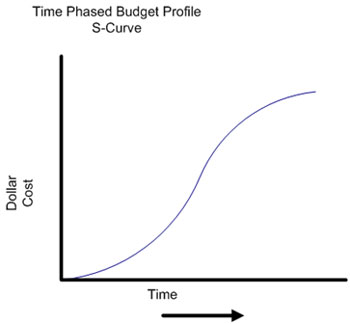Project budgets, similar to resource plans, are a reflection of project work and the timing of that work. A comprehensive budget provides management with an understanding of how funds will be utilized and expended over time for projects or operations.
The S-Curve displayed below shows the estimated cumulative expenditures of the project over time. In general, a project expends resources slowly, ramps up rather quickly as more resources are utilized and then tapers off as the project comes to completion.
Most project expenditures follow this pattern, resulting in a graphical representation that resembles an "S". Knowing the timing of expenditures on a project will assist management in planning appropriately.

High-level estimates, provided by management in advance of a project's start, are not budgets. In Project Insight, these high-level estimates are named 'target budgets.' A comprehensive budget can only be developed as a result of the project schedule and resource plan. Therefore, the better you identify all the work of the project within your schedule and the types of resources necessary to complete the work effectively, the more accurate your budget will be.
Building the Planned Project Budget
The Work Breakdown Structure (WBS) is the basis for any budget. The WBS includes all the work necessary to create the product of the project. The WBS is created through a decomposition process resulting in deliverables defined at the lowest level of the WBS—work package or what is called a 'task' in Project Insight.
All of the efforts used in producing the deliverable of each task can be defined in terms of cost. Labor, materials, facilities, services and overhead are examples of costs that may be expended in producing the deliverable of the task.
The sum of all tasks within the WBS constitutes the total budget of the project. Project Insight performs bottom-up budgeting, which means that the tasks roll up into summary task totals, and the project total represents the sum of all tasks planned and actual costs.


Коментарі
Дописати коментар